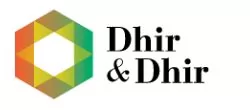1. INTRODUCTION
For the years 2015–2030, the 2030 Agenda defined 17 Sustainable Development Goals (SDGs) and 169 global goals pertaining to development outcomes and implementation means (MoI). These were created to balance the social, economic, and environmental aspects of sustainable development and to be integrated and indivisible.
The creation of SDG 6, ensures availability and sustainable management of water and sanitation for all. It is a reflection of the heightened importance given to water and sanitation concerns in the political agenda at the international level. Rising inequality, the depletion of natural resources, environmental degradation, and climate change are listed as some of the main concerns facing humanity in the 2030 agenda. It emphasizes the linked nature of SDGs and acknowledges that social progress and economic prosperity depends on the appropriate management of freshwater resources and ecosystems.
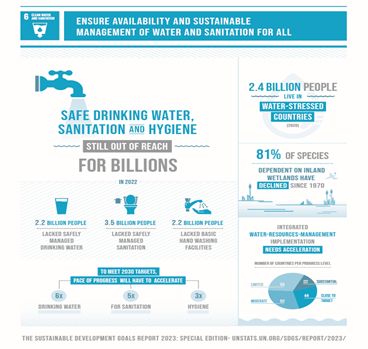
Figure 1: Sustainable Development Goal 6 (Source: https://unstats.un.org/sdgs/report/2022/)
All areas of life and sustainable development require access to clean, plentiful fresh water. The member states of the United Nations broadly acknowledge the human right to water and sanitation. Water resources are essential to sustaining economic growth in agriculture, industry, and energy production as well as preserving thriving ecosystems. For example, they are integral to ensuring food security, promoting health, and reducing poverty.
Human communities and civilizations have long found natural homes in water-related ecosystems and environments, which also give advantages like transportation, natural purification, irrigation, flood protection, and habitats for biodiversity. However, factors including population expansion, agricultural intensification, urbanization, pollution from industry, and climate change are starting to outpace and jeopardize nature's capacity to perform essential tasks and deliver essential services. According to estimates, by 2050, 45% of the world's gross domestic product, 52% of the world's population, and 40% of grain output will be at risk if the natural environment is continuously deteriorated and unsustainable pressures are placed on the world's water resources. Populations that are poor and marginalized will be disproportionately affected, which will exacerbate already-rising disparities.
By far, agriculture (including irrigation, cattle, and aquaculture) uses most water, comprising 69% of all annual water withdrawals worldwide. A 19% share goes to industry (including the production of electricity), while a 12% share goes to households. All of these water uses risk contaminating freshwater supplies. The majority of wastewater from municipal, industrial, and agricultural sources are dumped directly into aquatic bodies. If left untreated, this pollution weakens ecosystems and further lowers the amount of fresh water available for drinking and other uses.
There is growing consensus that the problems can be solved by implementing a more comprehensive strategy for managing and allocating water resources, including the preservation of ecosystems that are essential to civilizations and economies. The 2030 Agenda includes the idea of integrated water resources management (IWRM), which calls for Governments to take into account how society is connected by water resources and how decisions in one sector may influence water users in other sectors. In order to manage water in an equitable and sustainable manner, it requires the participation of all actors and stakeholders, from all levels, who utilize and potentially contaminate it.
1.1. CURRENT WATER SCENARIO IN INDIA
According to all international criteria, India is very susceptible to hydrological shocks due to its large population and significant reliance on the monsoon. Over 50% of India's annual rainfall falls in just 15 days, and 90% of its rivers flow during that time, causing floods in several regions of the nation. India may increase its water storage, which is now 209 m3 per capita compared to affluent nations like the USA (2192 m3), Canada (25337 m3), and Australia (3223 m3) (AQUASTAT Data), thanks to its enormous potential for rainwater collection. A thorough understanding of the water flow system and water resources in the basins/sub-basins has been made possible by the water balance modeling for the re-evaluation of water availability in Indian basins (Figure 2).
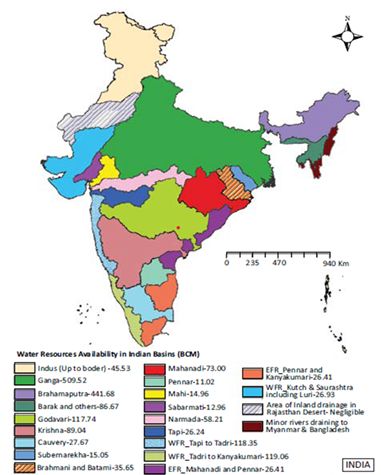
Figure 2: Basin-wise water resource availability (BCM) in India (Source: Reassessment of water availability in basins using spatial inputs, CWC, 2017)
The demand for water has been predicted by the National Commission for Integrated Water Resources Development (NCIWRD) between the years 2025 and 2050. The overall water demand is projected to reach 973 BCM under the low demand scenario and 1,180 BCM2 under the high demand scenario by the year 2050. Both geogenic and anthropogenic pollutants pose a threat to India's water resources.
Out of the 593 districts from which data is available, 203 districts are affected by high levels of fluoride, 206 districts are affected by iron, 137 districts are affected by salinity, 109 districts are affected by nitrate, and 35 districts are affected by arsenic, according to the Ministry of Drinking Water Supply and Sanitation, Government of India.
In May 2018, the Atal Bhujal Yojana (Abhy), a National Groundwater Management Improvement Program (NGMIP), was launched with the goal of advancing ongoing federal and state initiatives aimed at slowing the long-term decline of groundwater levels and enhancing the management of groundwater resources in a number of States. This World Bank-funded effort, worth Rs 6000 crore, seeks to stabilize the nation's groundwater levels and enhance groundwater institutions. The plan, which will be carried out by the Ministry of Water Resources, River Development, and Ganga Rejuvenation, intends to enhance ground water management in priority States through community involvement.
1.2. CURRENT WATER POLICY FRAMEWORK OF INDIA
The formation of India's numerous comprehensive national laws, policies, and programs is a continuous process, and multiple legislative initiatives and executive policies are currently up for consideration. The extent to which national laws can comprehensively handle the difficulties of the sector is limited because water is a State topic and there is also significant regional variety throughout India. As a result, State level legislation, regulation, and governance mechanisms must be used in addition to national laws to solve the sector's issues. Effective techniques and processes for operationalizing and monitoring policies are just as important as good policies themselves. The National Water Policy, National Water Mission, Model Groundwater Bill, Dam Safety Bill, and Interstate Water Disputes Amendment Bill are some of the key policy documents that need to be examined for both their content and the effectiveness of their implementation.
National Water Policy of India, 2012:
In response to the fast evolving water landscape, India's National Water Policy (NWP 2012) was created in order to address new concerns and offer crucial policy contributions. The NWP 2002, which for the first time highlighted ecological and environmental issues of water allocation, served as the foundation for this strategy. According to the Policy, managing water as a shared resource held by the State under the public trust doctrine is necessary to promote fair and sustainable development for all. The NWP 2012 also underlines the need for the State to gradually transition from serving as a service provider to acting as a regulator of services and a catalyst for the development of the necessary institutions. The NWP offers advice on a number of significant problems, including the following:
- Adapting to climate change
- Enhancing water availability
- Water demand management through efficient water use practices
- Project planning and implementation
- Management of flood and drought
- Preparation of a plan of action by the National Water Board based on the National Water Policy
National Water Mission Of India, 2008:
The Ministry of Environment, Forest and Climate Change (MoEFCC) has been designated as the nodal ministry in India's National Action Plan on Climate Change (NAPCC), which has established eight missions to implement programs and schemes and track the development of climate change-related issues. The eight missions include the National Solar Mission, Energy Efficiency Enhancement Mission, Green India Mission, Water Mission, Sustainable Habitat Mission, Sustainable Himalayan Ecosystem Mission, and Strategic Knowledge on Climate Change Mission.
The National Water Mission (NWM) of India's major goal is "water conservation, waste reduction, and more equitable distribution of water among and within States through integrated water resources development and management."
The Mission's five outlined objectives are:
Goal 1: Evaluation of the effects of climate change on water resources and creation of a comprehensive water database in the public domain;
Goal 2: Encouragement of state and citizen action to conserve, increase, and preserve water;
Goal 3: Draw attention to vulnerable locations, including those that are overused;
Goals 4 and 5 include the promotion of basin-level integrated water resources management and a 20% increase in water use efficiency.
Draft Water Framework Law of India, 2016:
In order to enable legislation and executive action on water at all levels of governance, the Draft National Water Framework (NWF) Bill, 2016, aims to establish a comprehensive national legal framework based on principles for the protection, conservation, regulation, and management of water as a necessary and underutilized natural resource. With the help of this Bill, State governments and local entities will be better able to manage their water systems. This is a crucial step in giving the nation's lowest administrative levels more control over the management of its water resources.
The Bill also pushes for a national water security plan, sets a legally binding baseline for water quality, and mandates that within six months of the Act's entry into effect, the States develop plans for managing and mitigating droughts. The Bill further specifies that the Drought Mitigation and Management Policy and Action Plan must identify programs and strategies for drought mitigation based on the various drought indices, as well as a drought risk and vulnerability assessment for the State. Priority is given to ensuring that everyone has access to the water they need to live, followed by funding for achieving food security, sustaining agriculture, sustainable livelihoods, and ecological needs.
The implementation of the 'right to water for life' marks a notable advancement, underscoring the government's duty to guarantee each individual's access to safe water. This constitutes a significant stride in the direction of fulfilling the Sustainable Development Goals (SDGs). Additionally, a forward-looking move involves accentuating the connections between Ground Water and Surface Water to strategize the growth and supervision of water within the river basin and the linked underground reservoirs. The acknowledgment of water as a shared vital resource crucial for supporting life in its entirety also stands out as a key element of the legislation.
Model Ground Water Bill, 2016
In June 2016, the Draft Ground Water Model Bill for the Preservation, Safeguarding, and Control of Groundwater was made available for feedback and suggestions on the Union Ministry of Water Resources' website, www.wrmin.nic.in. The essence of this Bill revolves around the principles of subsidiarity and fair distribution within a comprehensive strategy. As per the Bill's provisions, each State is tasked with the responsibility of being a custodian of groundwater, treating it as a communal resource to ensure its safeguarding, conservation, regulation, and effective management. The 2016 Model Ground Water Bill aims to enhance the welfare of groundwater resources by introducing plans for groundwater security and localized decision-making.
The Bill delineates a range of objectives, among them:
- Assuring the realization of the fundamental right to water, contributing to the preservation of life.
- Address requirements related to food security, sustenance, essential human necessities, animal husbandry, and aquatic ecosystems;
- Safeguard the integrity of ecosystems and their diverse biological components;
- Diminish and avert pollution and deterioration of groundwater quality.
In many ways, this Bill is an improvement over the earlier groundwater measures. In reality, the Bill intends to establish a framework to regulate and manage groundwater based on the public trust theory and the principle of subsidiarity for the very first time.
Compared to the present "open access" groundwater law, this is a huge improvement. It is also a great idea to quantify and control groundwater use in metropolitan areas and canal command regions. However, because the water is a State issue, the individual States would have to enact the actual legislation through their State legislatures.
1.3. IMPLICATIONS OF THE WATER POLICY FRAMEWORK OF INDIA ON SDG 6
Due to the inherent interconnections between water and various sectors, the water policy framework has ramifications that extend to nearly all aspects of public policies. The five key Ministries tasked with advancing Sustainable Development Goal 6 are:
- Ministry of Water Resources, River Development, and
Ganga Rejuvenation (MoWR, RD & GR): This ministry has
initiated numerous actions to revamp India's water sector. Some
of these forward-looking measures encompass bridging the gap
between created irrigation potential and utilized irrigation
potential, addressing the excessive exploitation of groundwater,
managing floods, enhancing drought resilience, facilitating
conflict resolution, ensuring dam safety, securing reliable data
availability, and tackling the declining water quality. The
National Mission for Clean Ganga stands as a prominent initiative
of this ministry. Under its umbrella, the Namami Gange program
represents an all-encompassing conservation mission sanctioned by
the Union Cabinet in May 2015, with a budget allocation of Rs.
20,000 crore spanning five years. The initiatives and plans of this
ministry, including Aviral Dhara, Nirmal Dhara, and Swachh Kinara,
have a direct influence on achieving Targets 6.3, 6.4, and
6.5.
- The Ministry of Drinking Water and Sanitation
(MoDWS): This ministry is dedicated to providing access to
clean drinking water and sanitation facilities in the rural regions
of India. The inception of the National Rural Drinking Water
Programme (NRDWP) took place in 2009, placing significant emphasis
on guaranteeing the lasting availability of water that meets the
criteria of being safe, sufficient, convenient, affordable, and
equitable. Restructuring of NRDWP has been proposed to enhance its
focus on producing tangible outcomes, fostering competition, and
ensuring better monitoring, all while prioritizing the
sustainability (functionality) of initiatives to guarantee the
delivery of high-quality services to the rural populace. NRDWP is
addressing SDG Target 6.1, while the flagship program Swachh Bharat
Mission-Grameen (SBM-G) is addressing Target 6.2.
- Ministry of Housing and Urban Affairs (MoHUA):
This ministry is tasked with implementing programs such as Swachh
Bharat Mission (Urban) to ensure hygienic sanitation access in both
urban and peri-urban regions across the nation. The ministry also
oversees initiatives like the Atal Mission for Rejuvenation and
Urban Transformation (AMRUT), which focuses on enhancing water
supply systems. This encompasses activities like reinforcing
existing water supply systems, reviving outdated water supply
systems, establishing decentralized and interconnected subterranean
sewerage networks, augmenting existing sewerage systems, and
developing sewage treatment plants. Additionally, the ministry
manages fecal sludge management, involving the cost-effective
processes of cleaning, transportation, and treatment. These
initiatives and plans have a direct effect on achieving Targets 6.1
and 6.2.
- Ministry of Environment, Forest and Climate Change
(MoEFCC): Within this ministry, the National River
Conservation Directorate oversees various strategies and
initiatives, including the National Water Mission, which is part of
the broader National Action Plan for Climate Change (NAPCC)
comprising eight missions. The initiation of river cleaning efforts
can be traced back to the inception of the Ganga Action Plan (GAP)
in 1985. Subsequently, this endeavour was expanded to encompass
other rivers under the National River Conservation Plan (NRCP) in
1995. The primary goal of NRCP revolves around enhancing the water
quality of the nation's major river sources through the
execution of measures aimed at curtailing pollution. The endeavours
and initiatives of this ministry have a direct influence on
accomplishing Targets 6.3 and 6.6.
- The Ministry of Agriculture and Farmers' Welfare (MoAFW) has introduced several prominent initiatives, including the Pradhan Mantri Krishi Sinchayee Yojana (PMKSY). This program has been categorized into 99 priority projects, each with distinct schedules. Initiatives like 'Har Khet Ko Paani' and 'Per Drop, More Crop' have been accelerated for swift implementation. The primary aim of PMKSY is to bring together investments in irrigation at the grassroots level, enlarge the cultivable land area with dependable irrigation, enhance the efficiency of on-farm water usage to curtail water wastage, promote the adoption of precision irrigation and similar water-conserving technologies, boost the replenishment of underground water reservoirs, and introduce sustainable approaches to water preservation. This includes exploring the viability of repurposing treated municipal wastewater for agriculture in peri-urban areas and encouraging increased private investment in precision irrigation systems. The initiatives and plans under this ministry are directed towards fulfilling SDG Target 6.4.
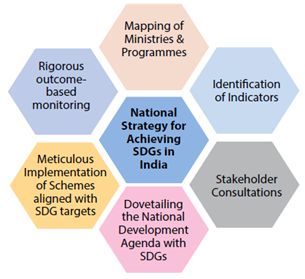
Figure 3: National Strategy of for achieving SDGs in India (Source: NITI Aayog, 2018)
1.4. P6 section of BRSR and NGRBC
The Business Responsibility Sustainability Reporting framework is associated with the National Guidelines for Responsible Business Conduct. It comprises three segments: (a) Section A, which encompasses General Disclosures, encompassing operational, financial, and ownership-related details, (b) Section B, which delves into Management and Process Disclosures, addressing the structures, policies, and methods employed to implement the Guidelines, and (c) Section C, which deals with Principle-wise Performance Indicators, evaluating the performance of businesses in their adherence to these Guidelines.
The primary purpose of this reporting framework is to function as an internal tool for businesses aiming to align themselves with the NGRBC. Section C divides the Performance Indicators into two categories: Essential Indicators and Leadership Indicators. Regardless of their size, sector, or ownership structure, all businesses should be able to fulfill the Essential Indicators to establish a fundamental level of responsibility. The degree to which they can fulfill these indicators reflects their level of maturity. The completion of Leadership Indicators indicates how far they have progressed on the journey of leadership, while any gaps in data identify areas for improvement.
Moreover, comparing the extent to which a business has implemented this framework in the current year compared to the previous year can help the company assess its progress toward leadership and whether its pace aligns with its aspirations. The term "P" refers to the Principles 1 to 9 as laid down in the National Guidelines for Responsible Business Conduct (P6 refers to Principle 6).
For the water related disclosures mentioned in the essential indicators of the P6 section of BRSR, following points are taken into consideration:
a. Details of total water withdrawn, consumed and water intensity ratio
- The organization must provide a comprehensive report on the
total water withdrawn for various purposes, specifying the source
breakdown as follows:
Surface water: This refers to naturally occurring water on the Earth's surface, including ice sheets, ice caps, glaciers, icebergs, bogs, ponds, lakes, rivers, and streams.
Groundwater: This pertains to water held in and recoverable from underground formations.
Third-party water: This encompasses water supplied by municipal sources and other private suppliers.
Sea-water / desalinated water: This includes water from seas or oceans.
Other sources: If significant, entities may detail additional water sources.
Additionally, the organization should report its overall water consumption, which measures the water utilized in a manner that is no longer available for use by ecosystems or local communities. This includes water that has been withdrawn and incorporated into products, evaporated, or become too polluted for other users. It also covers water stored during the reporting period for future use or discharge in subsequent periods. In cases where direct measurement of water consumption is not feasible, it can be calculated using the formula: Total water consumption = Total water withdrawal – Total water discharge.
Furthermore, the water intensity per rupee of turnover should be calculated as the total water consumed divided by the total turnover in rupees.
b. Zero Liquid Discharge policy
A zero liquid discharge system utilizes advanced wastewater treatment methods to recycle, reclaim, and subsequently reuse the treated wastewater, with the aim of preventing any discharge of wastewater into the environment.
For the water related disclosures mentioned in the leadership indicators of the P6 section of BRSR, following points are taken into consideration:
a. Details of water discharged
- The organization must provide a report on the total water
discharged, which includes all effluents and water released (either
unused or after use) that the organization no longer has a purpose
for. This report should include a breakdown of where this
discharged water goes, such as surface water, groundwater,
seawater, sent to third parties, or other destinations, as
specified in the guidance provided under Question 3 of Essential
indicators of P6. Additionally, the report should categorize the
discharged water based on the level of treatment it has
undergone.
- Furthermore, the organization has the option to categorize its
water discharge based on the following treatment levels:
Primary treatment: This level focuses on removing solid substances that settle or float on the water's surface.
Secondary treatment: This level aims to eliminate substances and materials that remain in the water or are dissolved or suspended in it.
Tertiary treatment: This level strives to enhance water quality to a higher standard before it is released.
- It includes processes designed to remove components such as
heavy metals, nitrogen, and phosphorus.
- If the organization withdraws and discharges high-quality water that doesn't require treatment, this exceptional circumstance should be explained in the report.
b. Details of water withdrawn, consumed and discharged in areas of water stress
- Water stress areas are defined as regions where there is a lack
of capacity to fulfill both human and ecological water needs. This
insufficiency can pertain to the presence, quality, or ease of
access to water. Additionally, regions labeled as
"over-exploited" or "critical" by the Central
Groundwater Board will be considered as water stress areas (Refer
to: http://cgwb.gov.in/gwresource.html).
- Furthermore, the organization may consult the guidance provided in Question 3 of Essential indicators and Question 2 of Leadership Indicators under P6 for additional information.
1.5. ROLE OF WASTEWATER MANAGEMENT IN ACHIEVING SDG 6
Water resources can be viewed as one of the most essential and critical assets for all developmental endeavours. The rise in urbanization, industrialization, and population growth has led to an increased demand for water, consequently exacerbating its scarcity and pollution. Until recently, wastewater was not recognized as a valuable asset, but now it's acknowledged as a fresh source of clean water suitable for both non-potable and potable applications. By subjecting wastewater to filtration and treatment processes, it's being repurposed for human consumption as well as a wide array of uses like industrial processes, irrigation, cleaning, and more. The reutilization of treated wastewater is serving various purposes and holds the potential to offer multifaceted benefits to societies in diverse forms.
In the context of the 17 Sustainable Development Goals (SDGs), SDG 6 is intricately linked with water and wastewater management, aiming to "ensure availability and sustainable management of water and sanitation for all." The successful realization of this goal, even to a certain extent, would greatly enhance the well-being of individuals on a global scale. The value of clean water is paramount in enhancing quality of life and driving socio-economic progress, while simultaneously fostering environmental preservation and promoting public health.
The formulation of SDG 6 (Clean Water and Sanitation) was primarily aimed at guaranteeing universal access to sustainable water and sanitation management by the year 2030. The subsequent sections delve into an extensive exploration of the correlation between wastewater treatment and various targets within other SDGs. Illustrated in Figure 4, the interconnection between SDG 6 and the remaining SDGs is visually depicted.
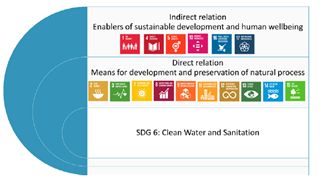
Figure 4: Relationship between SDG 6 and other SDGs (Source: Obaideen, K., Shehata, N., Sayed, E. T., Abdelkareem, M. A., Mahmoud, M. S., & Olabi, A. G. (2022). The role of wastewater treatment in achieving sustainable development goals (SDGs) and sustainability guideline. Energy Nexus, 7, 100112.)
In contemporary times, wastewater systems hold a vital role in
averting diseases and upholding sanitation standards through the
elimination of detrimental bacteria, viruses, and parasites. Both
societies and governments have displayed significant interest and
commitment in establishing systems capable of delivering purified
and reusable water. The management of wastewater encompasses
fundamental aspects of clean water and sanitation, prompting
considerable investment to harness the advantages tied to it. The
potential risks associated with wastewater are notably substantial,
thus making the implementation of efficient wastewater management
an imperative necessity
2. UNDERSTANDING HYDROLOGY
The concept of hydrology is significant for both people and their environment. It covers earth's water, its occurrence, movement, and distribution, as well as its chemical and physical characteristics and how these interact with the environment and other living things (Ray et al., 1975). It also discusses how water interacts with the environment during each stage of the hydrologic cycle. Hydrologic systems have seen several changes as a result of fast urbanization and industrialization, including deforestation, alteration of the land's cover, and irrigation.
Soil heterogeneity has a direct impact on numerous rivers' discharges worldwide, in addition to climate change. To identify these differences, many hydrologic phenomena and the hydrologic cycle must be properly researched. Today, a variety of hydrological models have been created all over the world to investigate the effects of soil and climate characteristics on hydrology and water resources. Every model has a set of distinctive qualities. Rainfall, air temperature, soil properties, terrain, vegetation, hydrogeology, and other physical parameters are among the inputs that various models employ. These models can all be used in basins that are both huge and extremely complex.
When water scarcity, surplus, dissolved or solid content are of the utmost concern, hydrologic modeling is employed to provide solutions to environmental transport problems (Burges et al., 1986). There isn't a single best model because environmental forecasts are so diverse. Instead, there are numerous tenable options, depending on the goal and required complexity. Because of this and other factors, the practice of hydrologic modeling has typically placed an undue emphasis on mathematics at the expense of real knowledge and is in need of a more thorough assessment of suitability (Kleme et al., 1997). Model choice is typically more influenced by familiarity than by appropriateness (Addor et al., 2019; Melsen et al., 2019). Hydrologic modeling is significantly hindered by process uncertainties, the dominating influence of heterogeneities, and other poorly understood and poorly characterized natural phenomena (Troch et al., 2009). As a result, there are numerous hydrologic models, all of which are insufficient and falsifiable in all but the simplest of circumstances.
Despite the fact that the hydrologic cycle (Fig. 5) is a worldwide phenomenon, local responses to frequent large-scale meteorological forcing are caused by global processes that act locally in response to locally-specific conditions. As a result, there is what is known as the uniqueness of site in hydrology (Beven et al., 2000). In terms of process sensitivity, hydrologic responses frequently display threshold behaviors as a function of system state, both in space and time. As a result, there are areas of state-space where some processes and their parameters are irrelevant. In order to provide correct mathematical descriptions without the use of high spatial resolution, heterogeneity and extremely non-linear and unpredictable material constitutive relations must be taken into account. Numerous hydrologic state variables are discontinuous and intermittent, which makes it difficult to mathematically describe them using continuum methods. For a variety of reasons, environmental prediction issues all under the category of "wicked problems" (Rittel et al., 1973; Webber et al., 1973), but typically because the answer to any given hydrologic question is "it depends."
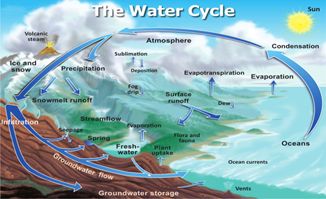
Figure 5: Conceptualization of the hydrologic cycle showing relevant fluxes and storages
(Source: https://www.sciencedirect.com/topics/earth-and-planetary-sciences/hydrological-modeling
A model, in the words of Sorooshian et al. (2008), is a condensed depiction of a real-world system. The best model is the one that produces results that are near to reality while utilizing the fewest parameters and the least amount of model complexity. Models are primarily used to analyze various hydrological processes and anticipate system behavior. A model is made up of a number of parameters that specify its properties. A runoff model is a series of equations that aids in estimating runoff as a function of several parameters used to describe the characteristics of a watershed. All models need drainage area and rainfall data as two crucial inputs. Additionally, factors including soil qualities, vegetation cover, watershed topography, soil moisture content, and ground water aquifer characteristics are taken into account. Today, hydrological models are regarded as a significant and essential tool for managing water and environmental resources.
2.1. Types of Models
Model inputs, model parameters, and the extent to which physical principles are utilized in the model are used to categorize rainfall-runoff models. Based on the model parameters' relationships to space and time, it can be divided into lumped and distributed models, as well as deterministic and stochastic models, depending on the other factors.
For a single set of input values, deterministic models will create the same result, whereas stochastic models may yield multiple output values. A distributed model can produce predictions that are distributed in space by dividing the entire catchment into small units, typically square cells or triangulated irregular networks, so that the parameters, inputs, and outputs can vary. This is in contrast to lumped models, which take the entire river basin as a single unit and ignore spatial variability, according to Moradkhani et al. (2008) and Sorooshian et al. (2008).
Based on the time factor, static and dynamic models are another classification. Dynamic models involve time while static models do not. Event-based and continuous models were the categories that Sorooshian et al. (2008) assigned to the models. The latter creates a constant output, whereas the former only produces output for brief intervals of time. The categories of empirical models, conceptual models, and physically based models are among the most significant.
A. Empirical model (Metric model)
|
i. Observation-oriented and mere use of information from the available data : Data-driven models ii. The unit hydrograph is an illustration of this approach iii. Regression and correlation models are employed in statistically - determine the functional relationship between inputs and outputs |
B. Conceptual methods (Parametric models)
|
i. All of the constituent hydrological processes are described in this model ii. Made up of several interconnected reservoirs - serve as a representation of the physical components of a watershed. iii. Employs semi-empirical equations iv. The Stanford Watershed Model IV (SWM), which Crawford and Linsley created in 1966, is the first significant conceptual model. |
C. Physically based model
|
i. Idealized mathematical depiction ii. Incorporates the fundamentals of physical processes - mechanistic ones iii. Employs measurable state variables that are both time and space dependent iv. This method calls for a vast quantity of data, including soil moisture content, beginning water depth, terrain, topology, river network dimensions, etc v. A good example is the SHE/MIKE SHE model. (Abbott et al. 1986 a, b) |
Table 1: Characteristics of three models (Devia, G. K., Ganasri, B.
P., & Dwarakish, G. S. (2015). A review on hydrological models.
Aquatic procedia, 4, 1001-1007.)
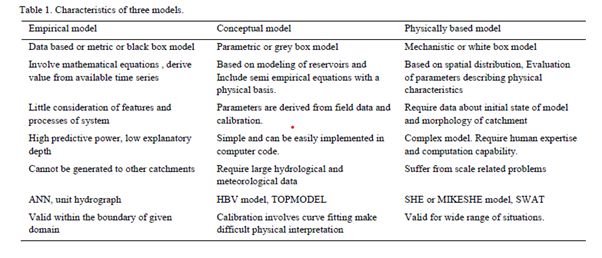
2.2. Brief Description of few models
a. SWAT Model (Soil and Water Assessment tool)
The Simulator for Water Resources in Rural Basins (SWRRB) model was replaced by the SWAT model, which is still being developed. The SWAT model, which was developed to test and forecast water and sediment circulation as well as agriculture productivity with chemicals in ungauged basins, is a sophisticated physical model. Long-term simulations can be carried out effectively with it. The model divides the entire catchment into sub catchments, which are further subdivided into land use, vegetation, and soil characteristics, as well as hydrologic response units (HRU). This model can represent water and sediment circulation, vegetation development, and nutrient circulation. It uses daily rainfall data, maximum and lowest air temperatures, solar radiation, relative air humidity, and wind speed as inputs. The amount of precipitation and mean daily air temperature can be used to calculate the rate of snowfall. For estimating evapotranspiration, Penman Monteith, Priestly- Taylor, and Hargreaves methods are utilized. The following water balance equation is used in the catchment by the model in order to simulate the hydrologic cycle, which incorporates overall water circulation, in order to generate accurate forecasts of water, nutrient, and sediment circulation.
|
SWt = SW0 + ∑ti=1 (Rv – Qs - WSeepage – ET – Qgw) |
Where SWt is the humidity of soil, SWo is
base humidity, Rv is rainfall volume in mm water, Qs is the surface
runoff, WSeepage is seepage of water from soil to underlying
layers, ET is evapotranspiration, Qgw ground water runoff and t is
time in days).
b. MIKE SHE Model (Systeme Hydrologiquue Eurpoean)
The model takes into consideration a variety of hydrological cycle processes, including rainfall, evapotranspiration, interception, river flow, saturated ground water flow, unsaturated ground water flow, etc. It can be used for large watersheds and can mimic the flow of surface and ground water, their interactions, the transfer of sediment, nutrients, and pesticides in the model region, as well as several issues with water quality. Evapotranspiration is determined using the Kristensen and Jensen (1975) method.
c. HBV model (Hydrologiska Byrans Vattenavdelning model)
An illustration of a semi-distributed conceptual model is provided by this model (Bergstrom et al., 1976). Sub catchments, which are further separated into various elevations and vegetation zones, make up the total catchment. It is powered by evaporation, air temperature, and daily and monthly rainfall data. Data on air temperature are used to estimate snowfall. The general water balance equation used is (2).
|
P – E – Q = d/dt (SP + SM + UZ + LZ +lakes) |
Where P stands for precipitation, E for evaporation, Q for runoff, SP for snow cover, SM for soil moisture, UZ and LZ for upper and lower ground water zones, and lakes for lake volume.
There are now various model iterations that are employed in various nations with various climate circumstances. Snow buildup and snow melt simulations are done using the degree-day approach. A new version of the HBV model called HBV-light utilizes a warm-up phase during which the state variables will receive their suitable values in accordance with meteorological data and value parameters.
d. VIC model (Variable Infiltration Capacity model)
It is a semi-distributed grid-based hydrological model that employs equations for the water and energy balances. Precipitation, minimum and maximum daily temperatures, wind speed, and a variety of land cover types are allowed inside each model grid as the key inputs. Infiltration, runoff, base flow, and other processes are based on a variety of empirical relations. Infiltration excess runoff (Hortonian flow) and saturation excess runoff (Dunne flow) are the two processes that produce surface runoff. In order to mimic saturation excess runoff, VIC takes soil heterogeneity and precipitation into account. It is made up of three layers. Quick soil evaporation is permitted by the top layer, the middle layer depicts the soil's dynamic reaction to rainfall events, and the lower layer is utilized to describe the behavior of soil moisture.
Both excess runoff from infiltration and excess runoff from
saturation are incorporated in the improvised VIC model, together
with the impacts of soil heterogeneity variability on surface
runoff characteristics. It can calculate the ground water table,
cope with the dynamics of surface and ground water interactions,
and be used in cold climates (Gao et al., 2010). Today, the model
is used to predict changes in the study area's climate and land
cover across a number of river basin.
3. CASE STUDY : SMART WATER MANAGEMENT INITIATIVE IN KOREA
3.1. Smart water management
Numerous technological solutions have been employed in water management to address different water-related challenges and improve the effectiveness of water control. In recent times, the integration of information and communication technologies (ICT) has been utilized to enhance the efficiency of water production and distribution processes. Byeon et al. (2015) highlight how these technologies are employed at each stage to achieve maximum efficiency. Concurrently, various ongoing research initiatives are focused on creating Smart Water Grid (SWG) technologies (Byeon et al., 2014) and implementing these innovations to ensure a sustainable water supply in Korea. This involves connecting water sources and optimizing water treatment techniques through the application of ICT, as explored by Choi and Lee (2013).
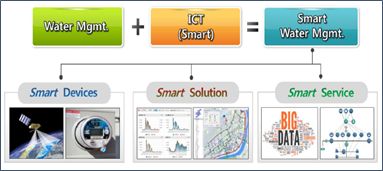
Figure 6: Concept of SWM (Source: Choi, G. W., Chong, K. Y., Kim, S. J., & Ryu, T. S. (2016). SWMI: new paradigm of water resources management for SDGs. Smart Water, 1, 1-12.)
SWM represents a forward-looking approach to water management, capable of seamlessly integrating and overseeing the complete water cycle – encompassing the assessment of present conditions, the purification, distribution, utilization, and even the systematic recycling of water resources in a scientific manner.
3.2. Conceptual overview of the smart water management initiative
Functioning as a state-owned enterprise, K-water bears the responsibility of overseeing the complete water cycle, spanning from water sources to end-user faucets. This includes the operational aspects of water treatment facilities. Consequently, it becomes crucial to effectively manage both water basins and water distribution networks in an interconnected manner, encompassing the treatment phase. Additionally, Information and Communication Technologies (ICTs) have been harnessed to enhance the efficiency of K-water's comprehensive water management endeavours through a methodical scientific approach.

Figure 7: K-water's ICT Application Timeline (Source: Choi, G. W., Chong, K. Y., Kim, S. J., & Ryu, T. S. (2016). SWMI: new paradigm of water resources management for SDGs. Smart Water, 1, 1-12
SWMI is a holistic model for water management, encompassing the entire spectrum from planning to execution, rooted in Integrated Water Resources Management (IWRM) and Smart Water Grid (SWG) principles (K-water, 2015). However, there has been some confusion and overlap concerning IWRM and SWG, largely due to their wide-ranging conceptual and operational interpretations. To tackle this issue, the SWMI framework first clarifies the extent and meanings of IWRM and SWG. In the context of SWMI, IWRM is understood as a methodical approach to water management with the following key attributes: a comprehensive assessment across basins and regions, unified governance involving various stakeholders, a thorough evaluation of economic, social, cultural, and environmental dimensions, along with technological considerations.
Figure 8 illustrates the principal framework of SWMI, outlining the incorporation of IWRM and SWG within SWMI, all centered around the entirety of the water cycle.
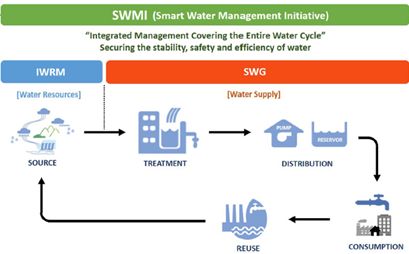
Figure 8: SWMI Conceptual Map (Source: Choi, G. W., Chong, K. Y., Kim, S. J., & Ryu, T. S. (2016). SWMI: new paradigm of water resources management for SDGs. Smart Water, 1, 1-12)
3.3. Implementation of SWMI
A trifold approach was formulated to enact SWMI, achieved by advancing and employing technologies throughout the complete water cycle system. The initial phase, referred to as K-Tech Tree, revolves around creating the essential technologies required for SWMI implementation, taking into account the existing technological landscape. The subsequent phase, known as STEP-ISP, involves the standardization of both current and forthcoming technologies, contingent on their particular types. The final step entails the establishment of a uniform framework for the application of technologies engendered by K-Tech Tree and STEP-ISP.
Technology development – K-tech Tree
K-Tech Tree was established as a strategic approach to identify essential technologies and facilitate their development for the successful implementation of SWMI. Illustrated in Figure 9, K-Tech Tree is composed of three core components: technology categorization, existing technological landscape, and technology advancement.

Figure 9: Conceptual diagram for K-tech tree (Source: Choi, G. W., Chong, K. Y., Kim, S. J., & Ryu, T. S. (2016). SWMI: new paradigm of water resources management for SDGs. Smart Water, 1, 1-12)
The underlying principle of SWMI is to systematically manage the entirety of the water cycle, with each aspect of the organized water cycle segmented into specific technology categories. As depicted in Figure 10, this categorization was achieved by progressively breaking down the elements in a stepwise manner.
After K-water's technologies were methodically categorized, they underwent thorough evaluation and were associated with relevant classes designed as compartments for housing the technologies. Subsequently, the selection of technologies that needed development or enhancement to effectively execute SWMI was conducted based on the current state of available technologies. Furthermore, plans for the development of these necessary technologies were formulated through this process.
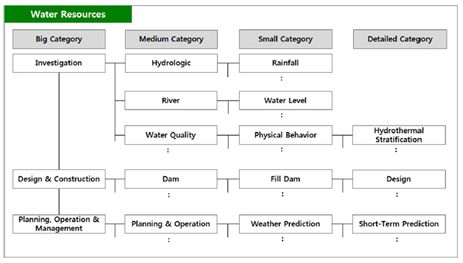
Figure 10: Example of technology classification (Source: Choi, G. W., Chong, K. Y., Kim, S. J., & Ryu, T. S. (2016). SWMI: new paradigm of water resources management for SDGs. Smart Water, 1, 1-12)
Standardization of Technology: STEP-ISP
Standardization is becoming increasingly crucial for achieving seamless integration among various technologies and enhancing the effectiveness of their application, especially due to the constant influx of diverse and intricate technologies in water management. Consequently, standardized technologies have the potential to enhance operational efficiency. To this end, the STEP-ISP (Standardization Technology Enhancement Project - ISP) strategy was devised, aiming to standardize technologies based on their respective types as correlated with K-Tech Tree. Illustrated in Figure 11, the concept of the STEP-ISP standardization strategy of K-water is depicted.
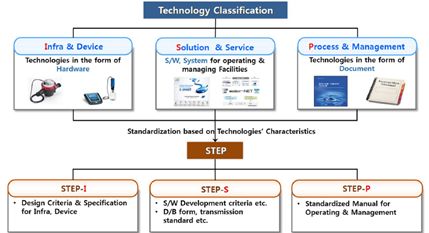
Figure 11: Conceptual Diagram of STEP-ISP (Source: Choi, G. W., Chong, K. Y., Kim, S. J., & Ryu, T. S. (2016). SWMI: new paradigm of water resources management for SDGs. Smart Water, 1, 1-12)
The STEP-I technique is used to standardize the installation of devices and services. As a public institution, K-water offers recommendations for design and device installation requirements. The STEP-S technique is used to standardize systems, including information and software. The strategy for standardizing each component has been developed taking into account the differences in S/W development and information use characteristics. Various organizations have used a range of information for managing water resources, and the amount of information has lately risen as a result of the complexity of water management responsibilities. ICT technologies are also continuously expanding in the realm of water management. The STEP-P standardization technique is used to manage and operate systems, equipment, and facilities.
Application of Technologies – standardized framework
The establishment of a uniform framework for using technologies obtained from phase-ISP and K-Tech Tree is the last phase. The created framework consists of tailored and modularized solutions to address water-related concerns in specific areas of interest. The framework includes an evaluation of the state of water management in the chosen area, result analysis, the creation of technologies, and their subsequent use to reduce vulnerabilities.
As illustrated in Fig. 12, the composition standard for the field of water resources management consists of four elements that represent the water cycle in a basin, including observation, dam, river, and city area. Additionally, each of the components includes technologies for smart water management, such as plans and schemes.
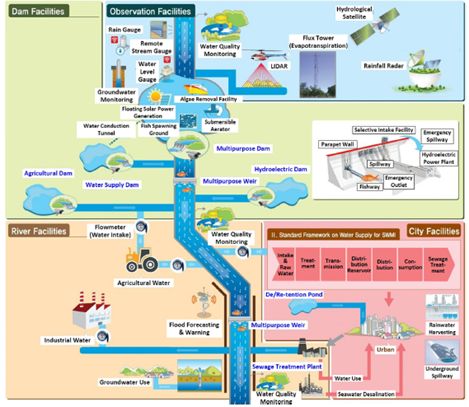
Figure 12: Composition Standard of the Water Resources Management Field (Source: Choi, G. W., Chong, K. Y., Kim, S. J., & Ryu, T. S. (2016). SWMI: new paradigm of water resources management for SDGs. Smart Water, 1, 1-12)
The final step involves employing the standardized framework to elevate the water management status of a specific region by addressing its vulnerabilities. This framework is constructed from modularized essential technologies developed within the K-Tech Tree and STEP-ISP, aimed at fulfilling the water resource management enhancement objectives of the targeted area. Moreover, the individual technologies comprising the standardized framework can be adjusted as required, depending on the outcomes of assessments, in order to better align with the set objectives.
This standardized framework is anticipated to enhance the effectiveness of identifying public investment projects that address water-related challenges. The direction of investment and the necessary technologies are determined by applying the standardized framework based on assessments of the water management situation. Furthermore, by employing this framework featuring standardized and modularized technologies, the time and resources expended in planning and launching new initiatives can be diminished through the establishment of a uniform business model.
Furthermore, this streamlined approach is poised to boost the efficiency of fostering new ventures, as the required technologies and enhancement goals are methodically established based on assessments conducted within the framework.
4. CONCLUSION
A hydrologic model replicates the movement, progression, or alteration of water storage over time within one or multiple components of the natural hydrologic cycle. A typical representation of the hydrological cycle is depicted using diagrams like the one created by the US Geological Survey (Fig. 1). Despite the well-established fundamental equations governing water flow, the complexity of these flows in the natural world arises due to the intricate nature of the environments in which they occur. This complexity is primarily attributed to variances that exist across a wide spectrum of spatial and temporal scales. These variations are significant because they greatly influence the direction of flow, flow speed, duration of stay, and can establish critical points of change that are contingent on the flow's trajectory and velocity.
In accordance with the Constitution of India, water is under the jurisdiction of the state governments, and the authority of the Central Government is limited. The Constitution also mandates the delegation of power from states to local entities such as Gram Panchayats and Urban Local Bodies. However, such decentralization of power within the water and sanitation sectors is currently inadequate. Nevertheless, the Central Government has introduced various laws, policies, and initiatives on a national scale, implementing them in coordination with the states.
Prominent policies and initiatives established within the water sector include the National Water Policy (NWP) of 2012, which is currently being revised, the National Water Mission (NWM) of India from 2008, The Draft Water Framework Law of India from 2016, the Model Ground Water Bill of 2016.
The primary aim of the National Water Mission (NWM) is centered around water preservation, reducing wastage, and achieving more equitable distribution at both inter-state and intra-state levels. NWM is executing a range of nationwide programs, including initiatives like 'Catch the rain, where it falls, when it falls' and 'Sahi Fasal' (The Right Crops).
The Draft National Water Framework Law serves as a comprehensive set of guiding principles for the water sector, dictating the powers of the Central Government, State Governments, and local governing bodies. This Bill encompasses diverse facets to prioritize water conservation and management. Notably, the 'right to water for life' approach represents a significant advancement, signifying the government's duty to ensure safe water access for every individual and contributing substantially towards attaining SDG 6. The underlying philosophy of the Model Groundwater (Sustainable Management) Bill, 2017 is rooted in the concepts of subsidiarity and fair water distribution. This bill mandates the state to function as a custodian of groundwater, committed to safeguarding, conserving, regulating, and managing it. This is significant due to the prevailing practice wherein groundwater ownership is tied to land ownership. The Bill is designed to achieve several goals, including upholding the fundamental right to water access, safeguarding the ecosystem and its diverse biological components, and curbing pollution and deterioration of groundwater quality.
This article also mentions about how the effective treatment of wastewater holds significant potential in the pursuit of attaining the SDGs. Among the 17 SDGs, 11 of them experience indirect effects from wastewater treatment, while others experience direct impacts. Despite the potential, the industry encounters several challenges in both executing and assessing SDG targets within a wastewater context. These challenges underscore the intricate relationship between SDG 6 and other SDGs, with wastewater management profoundly influencing each of them. Consequently, the primary difficulty in crafting global indicators lies in monitoring the risks stemming from non-achievement of this objective. The identification of such indicators should be approached on a global scale, requiring collaboration among diverse organizations and Governments. A harmonized network involving policymakers, stakeholders, scientists, and engineers will serve to facilitate and enhance the accomplishment of SDG 6 and other SDGs. Additionally, a proposed set of indicators aims to augment the contribution of wastewater treatment facilities towards the SDGs.
Through the decentralization of SDGs to States and local governing bodies, enabling them to support the SDG achievement via grassroots initiatives, SDGs offer a blueprint for shaping local development policies (NITI Aayog 2019). Clearly, the states and Union Territories (UTs) serve as the main agents and contributors responsible for realizing the SDGs' success in India. Many Indian states have actively dedicated efforts towards attaining the water and sanitation targets set by the SDGs. Certain States are also making headway in integrating these efforts with other SDGs, harmonizing actions at both state and local administrative tiers.
Considering the intricate socio-economic landscape of India, attaining SDG 6 alongside other SDGs demands adept management of intricate trade-offs within a multifaceted operational context. To navigate this, a robust institutional framework is essential. It should facilitate vertical communication between the SDG coordination points at the Central and State levels, and simultaneously promote horizontal exchange of sector-specific policies among sectors and the SDG coordination units at both Central and State levels.
Significant amplification of investment within water-related sectors has been observed due to recent initiatives by the Central Government. This surge in investment plays a pivotal role in fostering an enabling environment for policy implementation. Accomplishing holistic optimization across all SDGs necessitates the inclusion of state-level policies related to other SDGs. Ultimately, this comprehensive approach will determine our ability to effectively optimize efforts as we strive to realize the 2030 Agenda for Sustainable Development.
5. REFERENCES
- Obaideen, K., Shehata, N., Sayed, E. T., Abdelkareem, M. A.,
Mahmoud, M. S., & Olabi, A. G. (2022). The role of wastewater
treatment in achieving sustainable development goals (SDGs) and
sustainability guideline. Energy Nexus, 7, 100112.
- Devia, G. K., Ganasri, B. P., & Dwarakish, G. S. (2015). A
review on hydrological models. Aquatic procedia, 4,
1001-1007.
- https://www.sciencedirect.com/topics/earth-and-planetary-sciences/hydrological-modeling
- https://sustainabledevelopment.un.org/content/documents/19901SDG6_SR2018_web_3.pdf
- https://www.teriin.org/sites/default/files/2018-11/water-resource-policies.pdf
- https://jalshakti-ddws.gov.in/sites/default/files/NRDWP_Guidelines_2013.pdf
- Choi, G. W., Chong, K. Y., Kim, S. J., & Ryu, T. S. (2016).
SWMI: new paradigm of water resources management for SDGs. Smart
Water, 1, 1-12.
- https://www.mca.gov.in/Ministry/pdf/NationalGuildeline_15032019.pdf
- https://www.sebi.gov.in/sebi_data/commondocs/may-2021/Business%20responsibility%20and%20sustainability%20reporting%20by%20listed%20entitiesAnnexure2_p.PDF
This article is for information purpose only. It is not intended to constitute, and should not be taken as legal advice, or a communication intended to solicit or establish commercial motives with any. The firm shall not have any obligations or liabilities towards any acts or omission of any reader(s) consequent to any information contained herein. The readers are advised to consult competent professionals in their own judgment before acting on the basis of any information provided hereby.
